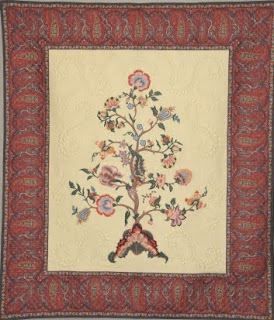Tree of Life by Barbara W. Barber, Westerly, Rhode Island
There are two Barbara Barbers in the quilt world.
The American BB specializes in Broderie Perse.
She'll be giving a trunk show of her work at the New England Quilt Museum on Sunday, September 12.
Contemporary Broderie Perse: An Elegant Revival is now open at the New England Quilt Museum. Curator Anita B. Loscalzo has invited several quilters who practice the old-fashioned art of Broderie Perse to show thirty pieces. She's also included a few antique examples.
Detail of Nosegay by Judy Simmons
The show will be up through October 17. It travels to the National Quilt Museum in Paducah: November 19, 2010 - February 15, 2011
Broderie Perse, also called Cut-Out Chintz, is a form of applique in which an image is cut from a piece of fabric and stitched to a background. Above, you can see how the floral has been cut from a white background and appliqued to another piece of white with a tiny stitch. We see it in the earliest American quilts. The style was almost completely replaced by conventional applique, in which the images are created in layers of plain and print fabric.
This spectacular early 19th-century example combining florals done in Broderie Perse and leaves done in conventional applique is from the Winterthur Museum's collection, on display now at the Milwaukee Art Museum.
I did a digital search in my PDF copy of Clues in the Calico to see what I said about Broderie Perse twenty years ago. I still agree with that information:
A number of American quilts and unquilted bedcovers in the technique survive that are attributed to the last quarter of the nineteenth century and at least six date-inscribed examples between 1782 and 1799 are in the literature. The technique is commonly called Broderie Perse, French for "Persian Embroidery". Caulfeild and Saward used that term in 1882 [in their book on needlework]; needlework historian Susan Burrows Swan believes it to be a late nineteenth-century name for a technique practiced earlier. Another late nineteenth-century name is Cretonne Applique [Cretonne is a synonym for chintz.] Page 102.
But now that I can search through 19th century books and magazines on Google Books I found an earlier reference to the terms in Peterson's Magazine in 1876.
CRETONNE APPLIQUE EMBROIDERY by Mrs. Jane Weaver
We give a very beautiful pattern in Cretonne Applique, now so fashionable. Great efforts, indeed, are made to introduce novelties in fancy work. Cloth is not so much used as last year; and yet there are some pretty bands in pale blue cloth (the shade known as dead turquoise,) with trails of autumn leaves embroidered with wool and silk. The foliage is worked in a new stitch called point de riz, and the autumn leaves are shaded from deep brown to pale gray. Bands thus worked are used for bordering curtains, or for placing down the centre of a chair or an ottoman. The work called in England cretonne applique, or broderie perse, is likewise very fashionable now; but here the foundation is black satin, and the colors are subdued, Watteau figures, cupids, birds, and flowers, are cut out from cretotnnes, chintzes, applique on the black satin, and so perfectly embroidered that it is impossible to detect the cretonne figures beneath. When a man or woman is cut out of the chintz, the faces are left untouched, but the hair is worked over, the effect is extraordinary, as until the process is explained, it is marvelous how the well-painted face got there.
Mrs. Weaver could have used a little editing, but you get her drift.
Why Persian Embroidery? Broderie Perse may refer to the oriental motifs---the tree of life, the exotic birds---often used in the technique. A similar needlework classification was Broderie Anglaise (English embroidery), which is a cutwork technique done in white fabric.
I have at least two friends with quilts in Anita's exhibit. Judy Severson and Bettina Havig have been working for months to get ready, keeping their pieces rather discreetly to themselves. Can't wait to see them.








Beautiful quilts! I am also currently quilting a broderie perse. I enjoy your posts.
ReplyDeleteI've only done a small broderie perse wallhanging but I love the effect. A few weeks ago I was on Edisto Island, S.C. There is a tiny town museum there that has an amazing broderie perse quilt on exhibit in their "plantation" room. It is the only quilt in the museum but worth the price of admission!
ReplyDeleteI wish I was close enough to enjoy the show.
ReplyDeleteThanks for the broderie perse education:)
You are a constant wealth of information and I always enjoy learning and (relearning) from you. :-)
ReplyDeleteThank you so much for the Broderie Perse information! I'm just now making the Morrell Quilt with lots of Broderie Perse,...
ReplyDelete